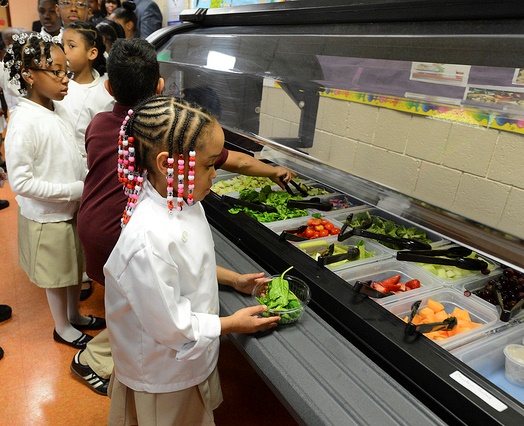 |
|---|
| Flickr: Maryland GovPics |
“It looks really beautiful! I would put our salad bar up against any salad bar in town because it looks that good!”– Kathy Burrill the food service director for Chisago Lakes Area Schools
Fresh fruits and vegetables are an invaluable source of nutrients, but many children and adolescents don’t eat enough of them! One popular initiative is to include a salad bar in the lunchroom. Offering an attractive, fresh variety of healthy greens and toppings for students to select is an effective way of meeting National School Lunch Program (NSLP) nutrition guidelines, increasing revenue, and boosting student satisfaction according to Kathy Burrill, the food service director for Chisago Lakes Area Schools.
Kathy applied for a grant to receive free salad bars from the Let’s Move Salad Bars to Schools initiative in 2012 and received two fully equipped salad bars! One is of standard size which she uses in her middle school cafeteria and a lower, smaller one for the intermediate school lunchroom. The salad bars came with containers of various sizes and reusable icepacks to keep the items fresh.
To build enthusiasm, Kathy created posters announcing the forthcoming salad bar addition and called them “super salad bars.” For the first year, she decided to bring out the bar twice a week, on Tuesdays and Thursdays, and so far it has been an enormous success with cafeteria staff, students and even teachers!
How to get a salad bar at your school
The Let’s Move Salad Bars to Schools initiative is part of Michelle Obama’s Let’s Move initiative which was founded to combat the childhood obesity epidemic in the US. In 2010, Let’s Move partnered with the Food Family Farming Foundation, the National Fruit and Vegetable Alliance, the United Fresh Produce Association Foundation and Whole Foods with a mission to bring a salad bar to every school in the US that participates in the National School Lunch Program. To date over 3,400 schools have been granted salad bars. Dozens of sponsors raise funds, and anyone can donate to the initiative right on the website. Kathy received her salad bar funding through the Whole Kids Foundation, a nonprofit arm of Whole Foods Market. Their mission is to support schools and inspire families to improve children’s nutrition and wellness. She did not have to raise any funding on her own. It took about nine months from the time Kathy submitted her application, until the salad bars arrived.
To apply for salad bars for your school district, first visit the Application Guidelines page to familiarize yourself with the process. Next, complete the online application to be added to the list of schools in the running for salad bars. Once your district is on the list, funds will compile from the programs sponsors as well as individual donors. Get your community involved in the effort by inviting local businesses and individuals to donate funds. Sharing the video below in your schools electronic newsletter or on your schools website, is a great way to incentivize you community to get involved in the effort.
For more information about the Let’s Move Salad Bars to School initiative, visit the website: www.saladbars2schools.org.
Contributors
Kathy Burrill, Chisago Lakes Schools
Katherine Baildon, Cornell Center for Behavioral Economics in Child Nutrition Programs
Photo by mdgovpics / CC BY http://creativecommons.org/licenses/by/2.0/
